Introduction
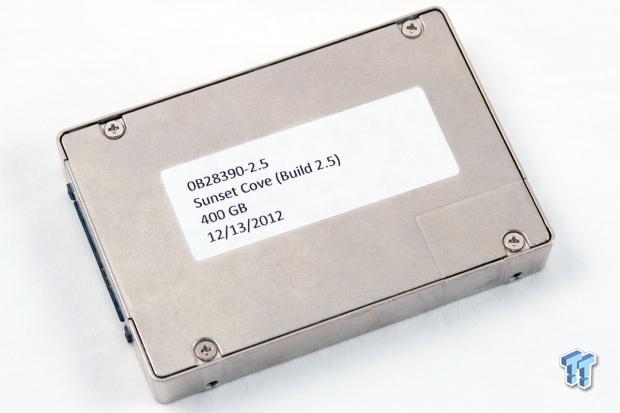
The release of the Ultrastar SSD800MM dual-port 12Gb/s SSD is the culmination of a long process of research and development, interoperability testing and qualification from HGST. Releasing a new storage product with a new interface is a lengthy process, evidenced by the demos that we have seen for nearly two years at a wide range of storage trade shows of the HGST SSD800MM.
HGST, a Western Digital company, has a long history of innovation in the SAS space. Developing the next generation of 12Gb/s SSDs also requires the other end of the hardware to be in place, such as an HBA or RAID controller. LSI and HGST have been working hand-in-hand and we are using the still-under-development LSI SAS 9300-8e to test the performance of the SSD800MM.
The SSD800MM is the middle child in a family of three Tier-0 12Gb/s SSDs from HGST, with each member providing a different level of endurance. The top-level offering is the High Endurance Ultrastar SSD800MH. The MH version features sequential throughput of 1,200/750 MB/s read/write, and 145,000/100,000 sustained read/write IOPS, respectively. This SSD provides the highest endurance with up to 25 DW/D (Drive Writes per Day) for the toughest workloads, such as HFT and OLTP environments.
The Read Intensive Ultrastar SSD1000MR brings up the low-end of the endurance pyramid, and features sequential speeds of 1,200/700 MB/s read/write and 145,000/70,000 read/write IOPS, respectively. With an endurance rating of 2 DW/D, this SSD is clearly intended for the write-once, read-many class of applications, such as audio/video streaming, cloud computing and other internet applications. While the other models top out at a capacity of 800GB, the SSD1000MR offers a larger 1TB capacity point.
The Mainstream Endurance Ultrastar SSD800MM in the lab today is for the middle ground, with up to 10 DW/D of endurance on tap. The SSD800MM brings blistering sequential throughput of 1,200/700 MB/s read/write, and 145,000/70,000 sustained read/write IOPS. This mid-level of SSD endurance is well suited for Big Data, online gaming and cloud computing applications.
The previous generation Ultrastar products employed varying types of flash as endurance technology has improved. The SSD400S utilized ultra-rugged 34nm SLC, and as NAND processes shrunk the SSD400S.B made the switch to 25nm SLC. The SSD400M brought about the inclusion of eMLC into the Ultrastar family, providing a lower level of endurance, but a more palatable price point as well.
The SSD800MM utilizes 'enterprise grade' 25nm MLC. eMLC brings higher endurance than standard consumer-grade MLC, yet still provides a much lower price point than SLC NAND. The eMLC provides up to 36.5 PB of endurance in the highest capacity SSD800MH, providing an excellent amount of endurance from MLC. The SSD800MM features 14.6 PB of endurance for the 800GB model.
HGST and Intel have enjoyed a great partnership over the years, with the jointly developed HGST/Intel DB29AA11AB0 controller and firmware powering the HGST enterprise SSDs. The strategic collaboration leverages Intel's industry leadership in core NAND and controller technologies and HGST's vast experience with the SAS interface.

To test the 12Gb/s HGST Ultrastar SSD800MM, we utilized LSI's newest 12Gb/s SAS 9300-8e HBA. The 9300-8e is currently unavailable to the public and is not utilizing production-level firmware. Even though the 9300-8e is still rough around the edges, it provides more than enough performance to test the SSD800MM.
The LSI SAS 9300-8e is built around the Fusion-MPT LSI SAS 3008 Fury controller. The 9300-8e provides eight ports of 12Gb/s connectivity that communicates via a x8 PCIe 3.0 interface. The 9300-8e supports RAID 0, 1 and 10 and utilizes the new Mini-SAS HD SFF-8644 external connectors. We will cover the new connectors and 12Gb/s SAS enhancements on the following pages.
HGST Ultrastar SSD800MM Specifications
The dual-port 12Gb/s SSD800MM weighs in with sequential throughput of 1,200/700 MB/s read/write, and 145,000/70,000 sustained read/write IOPS provided by 25nm Intel eMLC and the HGST/Intel DB29AA11AB0 controller and firmware.
With a focus on lowering TCO via low IOPS-to-Watt ratios (tested in the following pages), the HGST Ultrastar SSD800MM features two modes of operation to streamline the SSD for either performance or efficiency. The SSD800MM operates within different power consumption envelopes, with a 9 Watt and 11 Watt mode available. The SSD800MM features a capacitor for power hold-up in the event of a host power-loss issue and advanced power loss data management technology.
The SSD800MM operates in either 6Gb/s or 12Gb/s Active-Active dual/single port to provide enhanced reliability. The SSD incorporates the T10 Data Integrity Field (DIF) standard, extended ECC, and Exclusive-OR (XOR) parity to protect against flash die failure. Parity checked internal data paths protect data as it moves within the drive, and the SSD800MM does not use an external write cache. These technologies combine to provide the SSD800MM with an IE-17 non-recoverable error rate. A 2 million hour MTBF, and 0.44% AFR (Annualized Failure Rate), round out the reliability specifications.
The SSD800MM also comes with three levels of encryption support. TCG (Trusted Computing Group) encryption, TCG + FIPS 140 encryption, and Crypto Sanitize capabilities round out encryption support.
The SSD comes in a 2.5" form factor with a 15mm z-height and is available with a five year warranty in capacities of 800, 400 and 200 GB.

SAS 12Gb/s Architecture
The emergence of mega-datacenters and high-density deployments has required more connectivity features from SAS, while the simultaneous explosion of flash into the datacenter has required massive performance improvements at a pace unseen in the recent history of storage technology.

The regular update cadence of the SAS interface has provided a massive performance jump of 6-10X in the last three years. This rapid upgrade schedule and wide deployments will help SAS survive the challenge from new emerging specifications. While these new specifications have a number of appealing enhancements, they are still in their infancy with no working silicon in general availability.
One of the keys to success for the SAS interface has been existing infrastructure and backwards compatibility. The lack of backward compatibility, and infrastructure changes that could be required in some cases, can hinder widespread adoption of any new interface. Many refer to SAS as the 'Ethernet of storage'. Like Ethernet, SAS has been challenged by many different protocols over the years, but fast upgrade cycles and support for existing infrastructure have helped it weather those storms.

12Gb/s SAS is now entering general availability with HBA's and RAID controllers, and the new storage products to connect to them, being released over the next several months. The evolution to 12Gb/s SAS will continue for several years. The first 24Gb/s Plugfest is slated to begin in 2016, followed by end-user availability in 2017. This gives 12Gb/s SAS roughly four years before it is superseded by a more robust SAS protocol.

Aside from the bandwidth expansion, which allows 12Gb/s to fully saturate the PCIe 3.0 bus at 8,000MB/s, the upgraded architecture also brings new connectors that provide more expansive connection capabilities and enhanced density.
The new Mini-SAS HD (High Density) SFF-8643/8644 connections provide both an active and passive scheme for 6Gb/s and 12Gb/s SAS. These new connectors also sport an electrically improved design with less cross-talk and a better signal to noise ratio.
Adaptec recently switched to the HD connectors with their line of 6Gb/s products and other RAID and HBA vendors are expected to make the switch to Mini-SAS HD with 12Gb/s products. The smaller connector allows the connection of more devices to the smaller HHHL (Half Height, Half Length) controllers that are becoming commonplace in today's dense server deployments.
The expanded speed of 12Gb/s SAS will also raise the current cap of 24GBps throughput of a normal 4 lane SAS cable up 48GBps. This will enhance density by allowing the connection of more devices per expander before the connection between the HBA/RAID controllers becomes the bottleneck.

The SAS Connectivity Roadmap also points to a massive upgrade in cabling distances, with 20m for active copper and up to 100 meters with optical connections. This will provide a means for SAS to support box-to-box, server-to-storage, and rack-to-rack connections. In conjunction with SAS switches and expanders, active copper and optical can create an entirely new ecosystem within the datacenter. These new capabilities will enable expanded topologies for both custom builders and modular applications.

Improving the connectivity and ease of operation is a tall order, but the new Mini-SAS HD connectors deliver a spate of enhanced functionality. SAS Connectivity Management supports connection discovery and cable management by detecting the presence (or absence) of passive, active and optical connections. Along with rapid fault isolation and the minimization of configuration errors, this can simplify large-scale deployments significantly.
The only initial inhibitor for Mini-SAS HD will be the significantly higher price of cabling for the next few months. As we hit general availability and the economies of scale factor in, there should be significant easing of the pricing structure. Overall, the widespread adoption of these new connections and features with the 12Gb/s generation of storage devices will simplify and expand the capabilities of SAS; allowing for greater distance, scalability, usability and serviceability for large-scale deployments.
HGST Ultrastar SSD800MM Internals


The HGST SSD800MM comes in a 2.5" form factor with a 15mm Z-height. The case is a very hefty metal build that has a simple sticker identifying the SSD800MM as Sunset Cove Build 2.5. The bottom of the case is unremarkable with a single sticker identifying the part number. Upon removing the case, we observe the PCB secured with four additional fasteners. There are thick thermal pads on either side of the PCB to wick away heat from the NAND, DRAM and controller.


The SSD800MM features nine emplacements of 25nm Intel eMLC NAND on each side of the PCB. There are also two Micron DDR3-1600 DRAM chips totaling 1GB for internal drive functions. The HGST/Intel cooperation is apparent in the build of this SSD with the Intel logo emblazoned on the PCB, controller and NAND.

We typically observe arrays of Tantalum capacitors in many enterprise SSDs, but the HGST SSD uses a single capacitor connected to the PCB to provide for power hold-up in the event of power loss. This power-loss protection approach is similar to the method employed with the latest Intel SSDs.

The 25nm eMLC comes in 18 x 32GB packages, providing a total of 576GB of raw NAND. The unformatted capacity of the SSD totals 400GB of addressable space with 44% overprovisioning.

HGST and Intel jointly develop the surprisingly small 12-channel DB29AA11AB0 controller and firmware.
Test System and Methodology


We utilize a new approach to HDD and SSD storage testing for our Enterprise Test Bench, designed specifically to target long-term performance with a high level of granularity.
Many testing methods record peak and average measurements during the test period. These average values give a basic understanding of performance, but fall short in providing the clearest view possible of I/O QoS (Quality of Service).
'Average' results do little to indicate the performance variability experienced during actual deployment. The degree of variability is especially pertinent, as many applications can hang or lag as they wait for I/O requests to complete. This testing methodology illustrates performance variability, and includes average measurements, during the measurement window.
While under load, all storage solutions deliver variable levels of performance. While this fluctuation is normal, the degree of variability is what separates enterprise storage solutions from typical client-side hardware. Providing ongoing measurements from our workloads with one-second reporting intervals illustrates product differentiation in relation to I/O QoS. Scatter charts give readers a basic understanding of I/O latency distribution without directly observing numerous graphs.
Consistent latency is the goal of every storage solution, and measurements such as Maximum Latency only illuminate the single longest I/O received during testing. This can be misleading, as a single 'outlying I/O' can skew the view of an otherwise superb solution. Standard Deviation measurements consider latency distribution, but do not always effectively illustrate I/O distribution with enough granularity to provide a clear picture of system performance. We use histograms to illuminate the latency of every single I/O issued during our test runs.
Our testing regimen follows SNIA principles to ensure consistent, repeatable testing. We attain steady state through a process that brings the device within a performance level that does not range more than 20% during the measurement window. Forcing the device to perform a read-write-modify procedure for new I/O triggers all garbage collection and housekeeping algorithms, highlighting the real performance of the solution.
We measure power consumption during precondition runs. This provides measurements in time-based fashion, with results every second, to illuminate the behavior of power consumption in steady state conditions. Power consumption can cost more over the life of the device than the initial acquisition price of the hardware itself. This significantly affects the TCO of the storage solution. We also present IOPS-to-Watts measurements to highlight the efficiency of the storage solution.
It is important to bear in mind that our test pool features SSDs of varying capacity. With the first 12Gb/s SAS SSDs in hand we chose the 6Gb/s SMART Optimus in a dual port configuration as the 6Gb/s comparable. The 12Gb/s HGST SSD800MM and Toshiba PX02SMF080 were also tested in a dual port configuration on the same SAS 12Gb/s adapter.
The first page of results will provide the 'key' to understanding and interpreting our new test methodology.
4K Random Read/Write

We precondition the 12Gb/s HGST Ultrastar SSD800MM for 18,000 seconds, or five hours, receiving reports on several parameters of workload performance every second. We then plot this data to illustrate the drives' descent into steady state.
This chart consists of 36,000 data points. This is a dual-axis chart with the IOPS on the left and the latency on the right. The dark blue dots signify IOPS during the test, and the light blue dots are latency measurements during the test period. We place latency data in a logarithmic scale to bring it into comparison range. The lines through the data scatter are the average during the test. This type of testing presents standard deviation and maximum/minimum I/O in a visual manner.
Note that the IOPS and Latency figures are nearly mirror images of each other. This illustrates the point that high-granularity testing can give our readers a good feel for the latency distribution by viewing IOPS at one-second intervals. This should be in mind when viewing our test results below.
We also provide histograms for further latency granularity. This downward slope of performance happens very few times in the lifetime of the device, typically during the first few hours of use, and we present the precondition results only to confirm steady state convergence.

Each QD for every parameter tested includes 300 data points (five minutes of one second reports) to illustrate the degree of performance variability. The line for each QD represents the average speed reported during the five-minute interval.
4K random speed measurements are an important metric when comparing drive performance, as the hardest type of file access for any storage solution to master is small-file random. One of the most sought-after performance specifications, 4K random performance is a heavily marketed figure.
The HGST SSD800MM tops the chart with an amazing average of 147,429 IOPS at QD256. The Toshiba PX02SMF080 produces an average of 124,224 IOPS at QD256, followed by the SMART Optimus with an average of 100,290 IOPS at QD256 in dual port mode. The Optimus has the tightest read pattern with the least variability, but HGST takes off with 47,000 more IOPS in performance. The SSD800MM really hits its stride with the highest load at QD256.
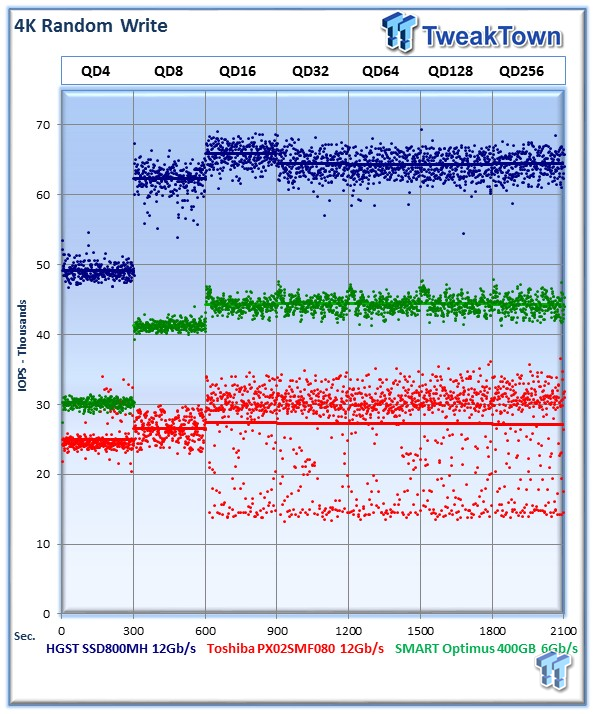
Garbage collection routines are more pronounced in heavy write workloads, leading to more performance variability.
The HGST SSD800MM leads the test pool with an average of 64,487 IOPS at QD256. The SMART Optimus averages 44,326 IOPS at QD256, the Toshiba 12Gb/s averages 27,165 IOPS at QD256, but significant performance variability muddies the performance picture. The HGST SSD800MM easily wins in this test.
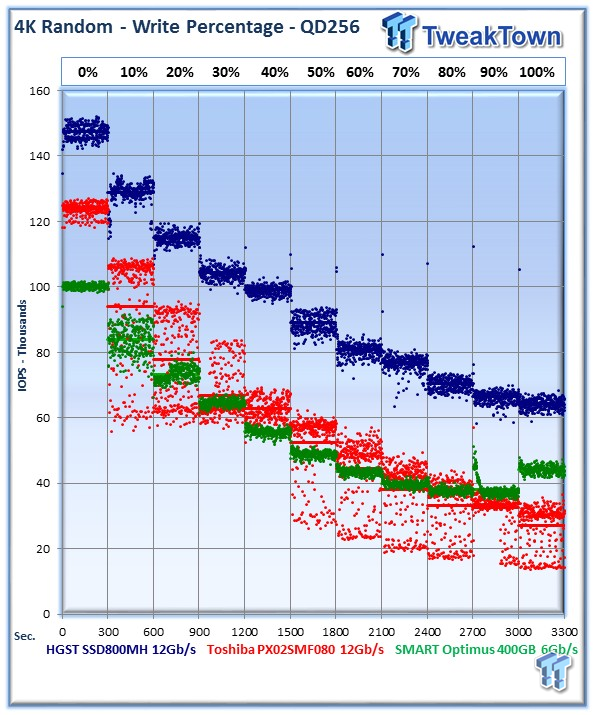
Our write percentage testing illustrates the varying performance of each solution with mixed workloads. The 100% column to the right is a pure write workload of the 4K file size, and 0% represents a pure 4K read workload.
The HGST Ultrastar leads this test with very strong performance across the board in the mixed read/write testing. The PX02SMF080 and the Optimus juggle second place. With the higher-endurance SSD800MH providing 100,000 write IOPS in steady state, this dominating performance gap would be even higher.

The HGST SSD600MM has a very tightly defined latency range with 64.75% (12,460,267 I/O's) landing at 2-4ms, and 33.31% (6,410,093 I/O's) in the 4-6ms range.

We record the power consumption measurements during our precondition run. We calculate the stated average results during the last five minutes of the test, after the device has settled into steady state.
The HGST averages 7.49 Watts, very close with the Optimus with an average of 7.51 Watts. The Toshiba sports significantly lower power consumption with an average of 5.63.

IOPS to Watts measurements are generated from data recorded during our precondition run, and the stated average is from the last five minutes of the test.
The HGST SSD800MM provides a great IOPS-to-Watts ratio of 8,396 IOPS per Watt. This is nearly double the 12Gb/s Toshiba PX02SMF080, which averages 4,843 write IOPS per Watt. The Optimus averages 5,906 write IOPS per Watt.
8K Random Read/Write

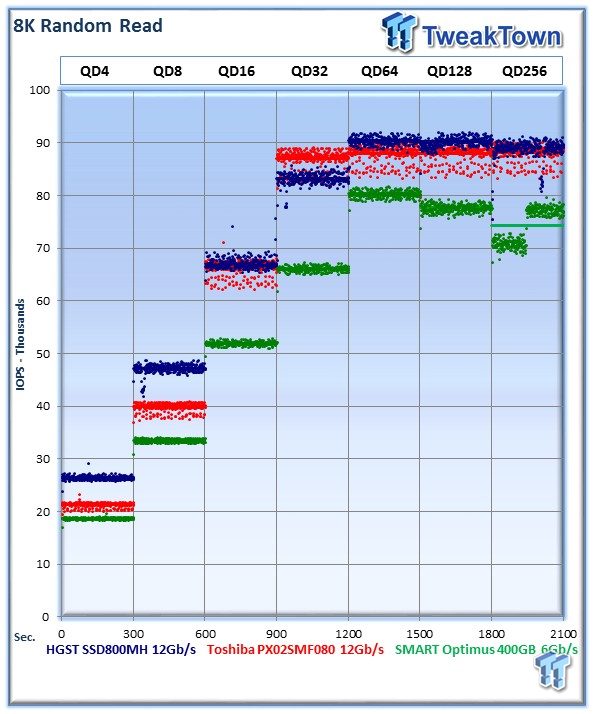
8K random read and write speed is a metric that is not tested for consumer use, but for enterprise environments this is an important aspect of performance. With several different workloads relying heavily upon 8K performance, we include this as a standard with each evaluation. Many of our Server Emulations below will also test 8K performance with various mixed read/write workloads.
The average 8K random read speed of the HGST SSD800MM is 88,909 IOPS at QD256, peaking at QD64 with 90,429 IOPS, providing the HGST a slight lead over the Toshiba PX02SMF080, which averages 88,120 IOPS at QD256. The Optimus manages an average of 74,240 IOPS at QD256, but peaks at 80,000 IOPS at QD64.

The average 8K random write speed of the HGST is a very solid 32,842 IOPS at QD256, and the Toshiba is 15,715 IOPS at QD256. The wide performance variability of the Toshiba again penalizes the average, while the Optimus delivers an average of 23,736 IOPS at QD256.

The Toshiba PX02SMF080 and Optimus vie for second place as we mix in more writes, but the HGST proves to be much more robust in heavier write workloads. Between the two 12Gb/s SSDs, the HGST drive has a much cleaner performance range.

The HGST SSD800MM has a large percentage of its 8K write activity, 51.35%, land in the range of 6-8ms. 33.1% of I/O falls into the 8-10ms range, and 10.23% lands at 4-6ms.

Power consumption for the HGST averages 7.37 Watts, while the Toshiba averages 6.07 Watts and the Optimus runs at 7.82 Watts.

The HGST flies above the other two SSDs and delivers 4,433 IOPS per Watt during preconditioning.
128K Sequential Read/Write


The 128K sequential speeds reflect the maximum sequential throughput of the SSD using a realistic file size encountered in an enterprise scenario.
The HGST SSD800MM has two performance modes. The efficiency mode is tuned for efficiency and draws 9-Watts of power, while the high performance mode draws 11-Watts and delivers maximum performance. We tested extensively with the different settings, and found the only performance benefit to be in sequential write situations. We included these 9-Watts results along with the 11-Watts tests, as the sequential testing was the only area we noticed drastically different behavior. All other testing is with the 11-Watt setting.
The difference between the two power modes does not show up in this workload, but below in the write testing, we will note a significant difference. The HGST SSD800MM averages an amazing 1,042 MB/s in sequential read speed, well above the competing SSDs. The Toshiba PX02SMF080 averages 823MB/s at QD256 in comparison to the Optimus with 586MB/s at QD256.

In our sequential write testing, we observe higher performance from the HGST SSD800MM in the 11-Watt performance mode. The 9-Watt setting delivers an average of 635 MB/s, while the 11-Watt setting bumps that up to 700 MB/s. A jump of 65 MB/s brings the HGST SSD800MM into the same sequential write performance envelope of the SMART Optimus.

The HGST SSD800MM has both 9-Watt and 11-Watt results included in the graph, but we can barely note a trace of the 11-Watt results. This is due to the nearly imperceptible difference in performance across the entire range of mixed read/write percentages. The extent of the difference lies in the 100% 128K sequential write workload. In mixed workloads, the higher power level does not provide any benefits.

The HGST Ultrastar SSD800MM provides an extremely tight performance range, with 1,442,399 I/Os (94.87%) at 40-60ms, and 77,863 I/Os (5.12%) at 60-80ms.

The HGST SSD800MM averages 9.53 Watts in the 11-Watt performance mode. With the 800GB capacity versions of the HGST SSD800MM featuring two PCB's we surmise that the extra NAND and PCB for the higher capacity 800GB model will bring this power draw into the 11 Watt range.
The 9-Watt performance setting actually consumes an average of 7.9 Watts during our testing.

The HGST provides an average of 73 MB/s per Watt in the 11-Watt performance mode, and the 9-Watt mode delivers a more economical 88 MB/s per Watt.
Database/OLTP and Webserver
Database/OLTP


This test emulates Database and On-Line Transaction Processing (OLTP) workloads. OLTP is in essence the processing of transactions such as credit cards and high frequency trading in the financial sector. Enterprise SSDs are uniquely well suited for the financial sector with their low latency and high random workload performance. Databases are the bread and butter of many enterprise deployments. These are demanding 8K random workloads with a 66% read and 33% write distribution that can bring even the highest performing solutions down to earth.
The HGST SSD800MM averages 59,259 IOPS during the measurement window, and exhibits a very tight range of performance in comparison to the Toshiba PX02SMF080.

The HGST provides 8,076,645 I/Os (45.6%) at 2-4ms, and 7,876,877 I/Os (44.47%) at 4-6ms.

The HGST averages 8.76 Watts during the precondition run.

The HGST averages 6,741 IOPS per Watt, losing by a scant 76 IOPS to the Toshiba PX02SMF080.
Webserver


The Webserver profile is a read-only test with a wide range of file sizes. Web servers are responsible for generating content for users to view over the internet, much like the very page you are reading. The speed of the underlying storage system has a massive impact on the speed and responsiveness of the server that is hosting the website, and thus the end-user experience.
The HGST SSD800MM averages 59,080 IOPS at QD256, followed by the Toshiba PX02SMF080 that averages 43,080 IOPS at QD256, and the Optimus, which averages 33,805 IOPS at QD256.

The HGST provides 47.15% of I/Os in the 4-6ms range, 41.47% of I/Os at 2-4ms, 8.9% of I/O's at 6-8ms, and 1.9% of I/O's at 1-2ms.

The HGST averages 5 Watts during the measurement window.
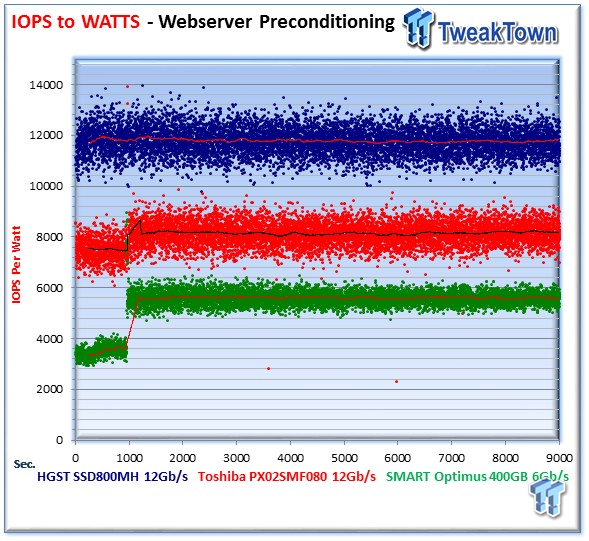
The HGST SSD800MM averages an excellent 11,816 IOPS per Watt, well above the other contenders.
Fileserver and Emailserver
Fileserver


The File Server profile represents typical file server workloads. This profile tests a wide variety of different file sizes simultaneously, with an 80% read and 20% write distribution.
The HGST takes a clear lead in this workload, with an average of 81,802 IOPS at QD256, the Toshiba PX02SMF080 averages 64,151 IOPS at QD256, well above the 45,736 IOPS mustered by the Optimus.

The HGST provides 18,961,536 I/Os (77.51%) at 2-4ms, 3,324,034 I/Os (13.58%) in the 4-6ms range, and 2,169,411 I/Os (8.86%) at 1-2ms.

The SSD800MM averages 4.91 Watts in steady state, much lower than the other SSDs in the test pool.

The HGST averages 16,709 IOPS per Watt, well above the competing SSDs.
Emailserver


The Emailserver profile is a very demanding 8K test with a 50% read and 50% write distribution. This application is indicative of the performance of the solution in heavy write workloads.
The HGST once again exhibits class-leading performance in this write-intensive test, with 47,124 IOPS at QD256.
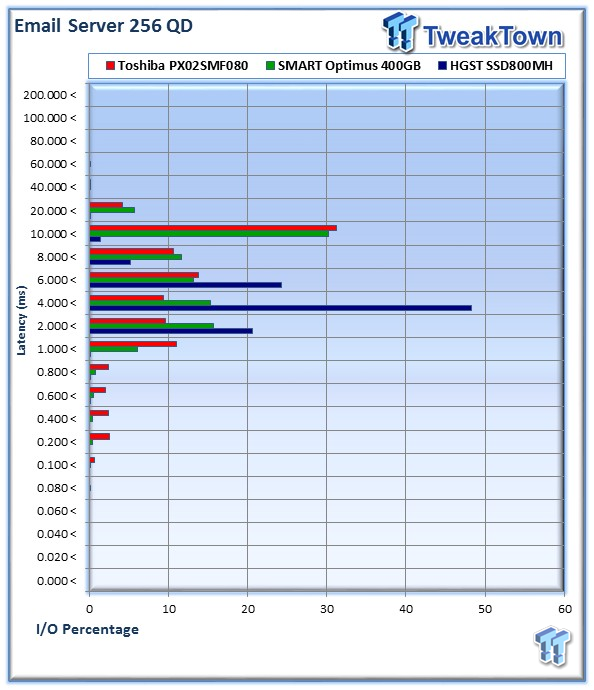
The HGST provides 48.25% of I/O's at 4-6ms, 24.25% of I/O's in the 6-8ms range, 20.62% at 2-4ms, and 5.16% at 8-10ms.

The HGST averages 6.52 Watts during the measurement window.
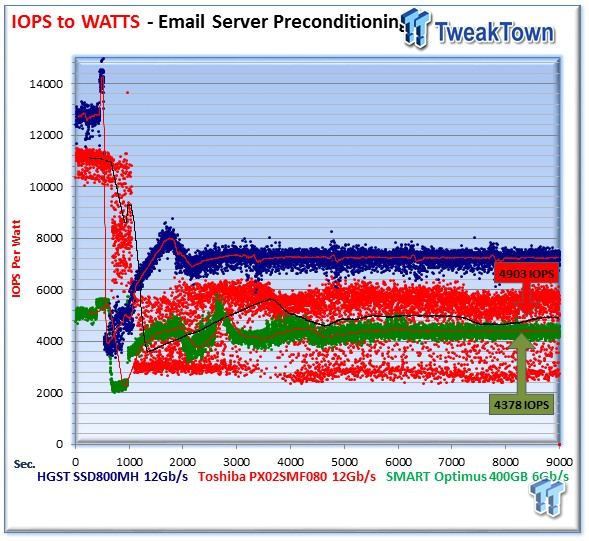
The SSD800MM averaged an outstanding 16,709 IOPS per Watt; again well above the competing solutions.
Final Thoughts

SAS SSDs and HDDs continue to be the building block of choice for enterprise and cloud storage. The incoming 12Gb/s specification doubles the throughput of the 6Gb/s interface, yet also provides features that will enable SAS to operate as a robust storage fabric. Providing high-performance SSDs to utilize the enhanced speed of 12Gb/s is a daunting task and HGST delivers a class-leading SSD that excels in a number of categories.
The SSD800MM is destined for ultra-high performance Tier-0 applications that require the very best performance. In the majority of deployments, utilizing multiple PCIe SSD's to address performance challenges is cost prohibitive. The HGST SSD800MM provides PCIe-like performance in a much smaller form factor that scales well in an enterprise setting.
The continuing collaboration between Intel and HGST has delivered a refined product. The HGST/Intel controller and firmware manages to wring impressive endurance from the 25nm eMLC NAND and delivers strong performance in heavy write workloads. With the recent news that Western Digital has acquired sTec, which will fall under the HGST umbrella, the future of the HGST/Intel partnership will be very interesting. With the enhanced controller IP and patent portfolio from sTec, HGST has a number of interesting options that were not available a few short weeks ago.
In our testing, the HGST drive delivered dominating performance across the board. The HGST SSD800MM led virtually every test, with the only challenge coming in the 128K sequential write testing. In 9-Watt mode, the SMART Optimus managed to best the HGST SSD800MM, but once we turned to the 11-Watt mode, the HGST matched the performance of the SMART Optimus. We tested extensively with both 9-Watt and 11-Watt modes, and found the performance increase focused around sequential write performance. This is a small niche for the increased speed, but for those with heavy write workloads, this will be beneficial.
In comparison to the only other 12Gb/s SSD available for comparison, the Toshiba PX02SMF080, the HGST delivered more consistent performance, particularly in heavier write workloads. The HGST SSD800MM offers up 14.6 PB of write endurance for the 800GB model, while the Toshiba also features 14.6PB of endurance for the same capacity point. The SMART Optimus, utilized as our 6Gb/s comparison SSD due to its excellent dual-port performance characteristics, provides a similar 13.9 PB of endurance. For those with more demanding heavy-write workloads there is the option of the HGST SSD800MH high endurance model, which sports an impressive 35.6 PB of endurance.
SAS SSDs generally tend to have higher power consumption due to their Active-Active dual port functionality. In our IOPS-to-Watts testing the HGST SSD800MM delivered dominating performance. The HGST SSD800MM offers up the best IOPS-to-Watts ratio of any of the Dual Port SAS SSDs in our test pool. This will have tremendous impact upon TCO over the service life of the drive.
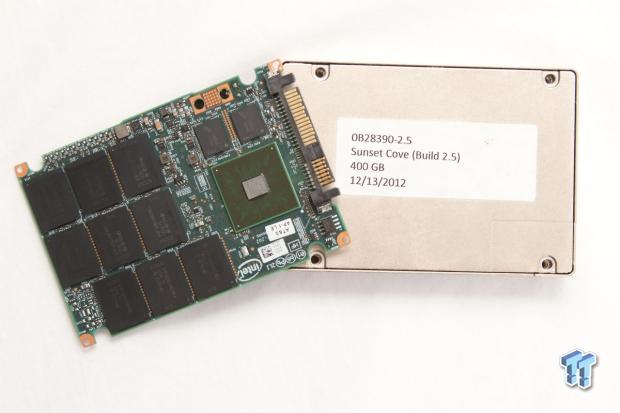
The HGST SSD800MM also provides a host of encryption options and numerous layers of protection from data corruption. T10 DIF, extended ECC, XOR parity, and parity checked internal data paths provide a 1E-17 non-recoverable error rate.
The broader implications of 12Gb/s SAS's enhanced density and new topologies created by longer cabling and management features will take time to penetrate into the datacenter, but storage devices like the HGST SSD800MM will hasten this transition with their offering of radically improved speed and density. Utilizing an HGST SSD800MM in existing 6Gb/s infrastructure will yield great results in random workloads, thought the sequential performance will be hindered by the 6Gb/s interface.
For being a newcomer with a new 12Gb/s interface, the HGST SSD800MM is a very polished offering. Delivering class-leading performance, consistency, data protection, efficiency and endurance is a tall order. HGST hits a home run on all accounts with the SSD800MM, and provides a five year warranty to guarantee the SSD. Considering all of the features, and simply outstanding performance from the HGST SSD800MM, it is a simple decision to award it the TweakTown Editor's Choice Award.

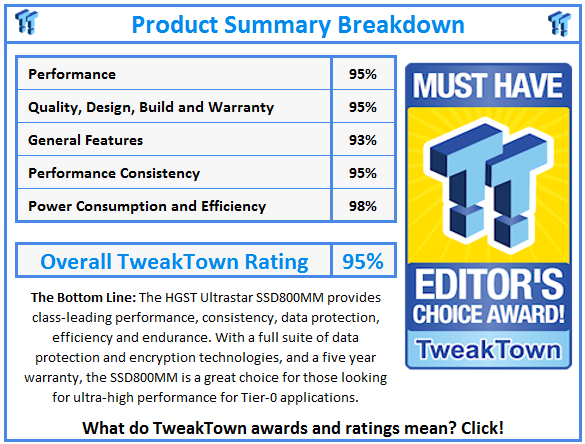
 United
States: Find other tech and computer products like this
over at
United
States: Find other tech and computer products like this
over at  United
Kingdom: Find other tech and computer products like this
over at
United
Kingdom: Find other tech and computer products like this
over at  Australia:
Find other tech and computer products like this over at
Australia:
Find other tech and computer products like this over at  Canada:
Find other tech and computer products like this over at
Canada:
Find other tech and computer products like this over at  Deutschland:
Finde andere Technik- und Computerprodukte wie dieses auf
Deutschland:
Finde andere Technik- und Computerprodukte wie dieses auf